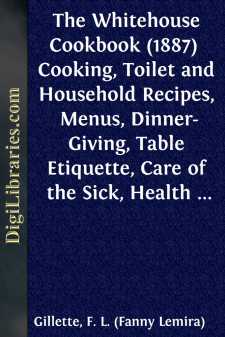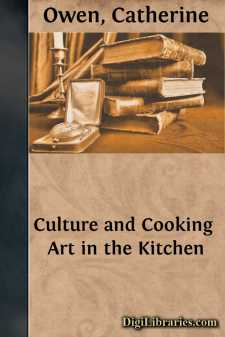Cooking
- General 70
- History 1
- Reference 10
- Regional & Ethnic 3
- Vegetarian 10
Cooking Books
Sort by:
by:
Elizabeth Moxon
ENGLISH HOUSEWIFRY. 1. To make VERMICELLY SOOP. Take a neck of beef, or any other piece; cut off some slices, and fry them with butter 'till they are very brown; wash your pan out every time with a little of the gravy; you may broil a few slices of the beef upon a grid-iron: put all together into a pot, with a large onion, a little salt, and a little whole pepper; let it stew 'till the meat...
more...
INTRODUCTION The word "fat" is one of the most interesting in food chemistry. It is the great energy producer. John C. Olsen, A.M., Ph.D., in his book, "Pure Food," states that fats furnish half the total energy obtained by human beings from their food. The three primary, solid cooking fats today are: There are numbers of substitutes for these, such as butterine, oleomargarine and...
more...
SUGGESTIONS TO TEACHER. Owing to the limitations of a text-book, it will be necessary for the teacher to enter very carefully into all the details of the various questions; to explain the underlying principles so thoroughly that "the why and the wherefore" of every action in the preparation of food will be clearly understood. She should endeavor to impress upon the pupils the value of...
more...
CARVING. Carving is one important acquisition in the routine of daily living, and all should try to attain a knowledge or ability to do it well, and withal gracefully. When carving use a chair slightly higher than the ordinary size, as it gives a better purchase on the meat, and appears more graceful than when standing, as is often quite necessary when carving a turkey, or a very large joint. More...
more...
GENERAL DIRECTIONS. The following directions may appear trite and common, but it is of the greatest consequence that they be strictly observed: Attend to minute cleanliness. Never wipe a dish, bowl, or pan, with a half dirty napkin, or give the vessel a mere rinse in water and think that it is then fit for use. See that it be dried and pure from all smell before you put in any ingredient. Never use the...
more...
by:
Catherine Owen
a few preliminary remarks Alexandre Dumas, père, after writing five hundred novels, says, "I wish to close my literary career with a book on cooking." And in the hundred pages or so of preface—or perhaps overture would be the better word, since in it a group of literary men, while contributing recondite recipes, flourish trumpets in every key—to his huge volume he says, "I wish to be...
more...
by:
Mary Randolph
SOUPS ASPARAGUS SOUP. Take four large bunches of asparagus, scrape it nicely, cut off one inch of the tops, and lay them in water, chop the stalks and put them on the fire with a piece of bacon, a large onion cut up, and pepper and salt; add two quarts of water, boil them till the stalks are quite soft, then pulp them through a sieve, and strain the water to it, which must be put back in the pot; put...
more...
by:
Mary Hooper
PREFACE. In presenting our friends and the public with the thirteenth edition of our "Home Comforts," we have the pleasure to remark that so greatly has the book been appreciated, that the large number of FIVE HUNDRED THOUSAND copies has been called for. The value of the Jubilee Edition was enhanced by some new recipes; these are repeated in the present edition, to which, also, some valuable...
more...
INTRODUCTORY CHAPTER The true economy of housekeeping is simply the art of gathering up all the fragments, so that nothing be lost. I mean fragments of time, as well as materials. Nothing should be thrown away so long as it is possible to make any use of it, however trifling that use may be; and whatever be the size of a family, every member should be employed either in earning or saving money....
more...
by:
Various
MY PET RECIPES TRIED and TRUE CONTRIBUTED BY THE LADIES AND FRIENDSOF ST. ANDREW'S CHURCHQUEBEC "We may live without poetry, music and art; We may live without conscience, and live without heart; We may live without friends; we may live without books; But civilized man cannot live without cooks."—Owen Meredith. QUEBEC "DAILY TELEGRAPH" PRINTING HOUSE 1900 Rhymes to Remember......
more...











